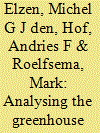|
|
|
Sort Order |
|
|
|
Items / Page
|
|
|
|
|
|
|
| Srl | Item |
| 1 |
ID:
121321


|
|
|
|
|
| Publication |
2013.
|
| Summary/Abstract |
As part of the Cancún Agreements, 45 non-Annex I countries have pledged mitigation action plans, of which 16 countries, including the seven major emitting countries, have submitted quantified mitigation actions. Many countries published their business-as-usual (BAU) emissions to which their pledges are connected. This study analyses the expected emission levels from the pledged, quantified actions, and whether these are consistent with achieving the 2 °C target. One of the main findings is that new BAU emission projections have led to about 2.5 GtCO2eq higher emission levels expected from pledges by non-Annex I countries. The emissions for non-Annex I countries as a group would be between 9% and 12% below our 2020 BAU emission projections, for, respectively, the unconditional and conditional pledges. This result might be conservative as we assume countries without quantified pledges follow BAU. This implies that for a medium chance of achieving 2 °C, Annex I countries would need to reduce its emissions by about 50% below 1990 levels by 2020. If Annex I countries as a whole would reduce emissions by 13% to 18% below 1990 levels, as expected from the pledges, the reduction of non-Annex I countries should be 22% to 34% below BAU levels for a medium chance of achieving 2 °C.
|
|
|
|
|
|
|
|
|
|
|
|
|
|
|
|
| 2 |
ID:
112894


|
|
|
|
|
| Publication |
2012.
|
| Summary/Abstract |
To meet ambitious global climate targets, mitigation effort in China and India is necessary. This paper presents an analysis of the scientific literature on how effort-sharing approaches affect emission allowances and abatement costs of China and India. We find that reductions for both China and India differ greatly in time, across- and within approaches and between concentration stabilisation targets. For China, allocated emission allowances in 2020 are substantially below baseline projections. Moreover, they may be below 2005 emission levels, particularly for low concentration targets (below 490 ppm CO2-eq). Effort-sharing approaches based on allocating reduction targets lead to relatively lower reductions for China than approaches that are based on allocating emission allowances. For 2050, emission allowances for China are 50-80% below 2005 levels for low concentration targets with minor differences between approaches. Still, mitigation costs of China (including emissions trading) remain mostly below global average. According to literature, Chinese emission allowances peak before 2025-2030 for low concentration targets. India's emission allowances show high increases compared to 2005 levels. If emission trading is allowed, financial revenues from selling credits might compensate mitigation costs in most approaches, even for low concentration targets. India's emission allowances peak around 2030-2040 for all concentration targets.
|
|
|
|
|
|
|
|
|
|
|
|
|
|
|
|
| 3 |
ID:
110428


|
|
|
|
|
| Publication |
2011.
|
| Summary/Abstract |
This study provides a conceptual framework for exploring the bargaining space within international climate negotiations based on important economic, political and environmental considerations. Based on it, we analyse combinations of the proposed emission reduction ranges for Annex I countries as a group (25-40% below 1990 levels) and non-Annex I as a group (15-30% below baseline) by 2020 to limit global warming to 2 °C. We use results of the FAIR model with costs estimates based on two energy system models. We conclude that the range of targets that comply with a set of criteria for economic, political and environmental considerations is smaller than that by environmental considerations alone. More specifically, we find that according to our criteria, a 30% Annex I reduction target below 1990 levels, combined with a 20% non-Annex I reduction target below baseline emission levels (i.e. 20 to 30% above 2005 levels), is the only combination of targets fulfilling all our criteria for both energy system models. Otherwise, reaching the 2 °C target becomes less likely, technically infeasible, or non-Annex I abatement costs are likely to exceed those of Annex I, a result, which we consider less plausible from a political viewpoint in our conceptual framework.
|
|
|
|
|
|
|
|
|
|
|
|
|
|
|
|
|
|
|
|
|